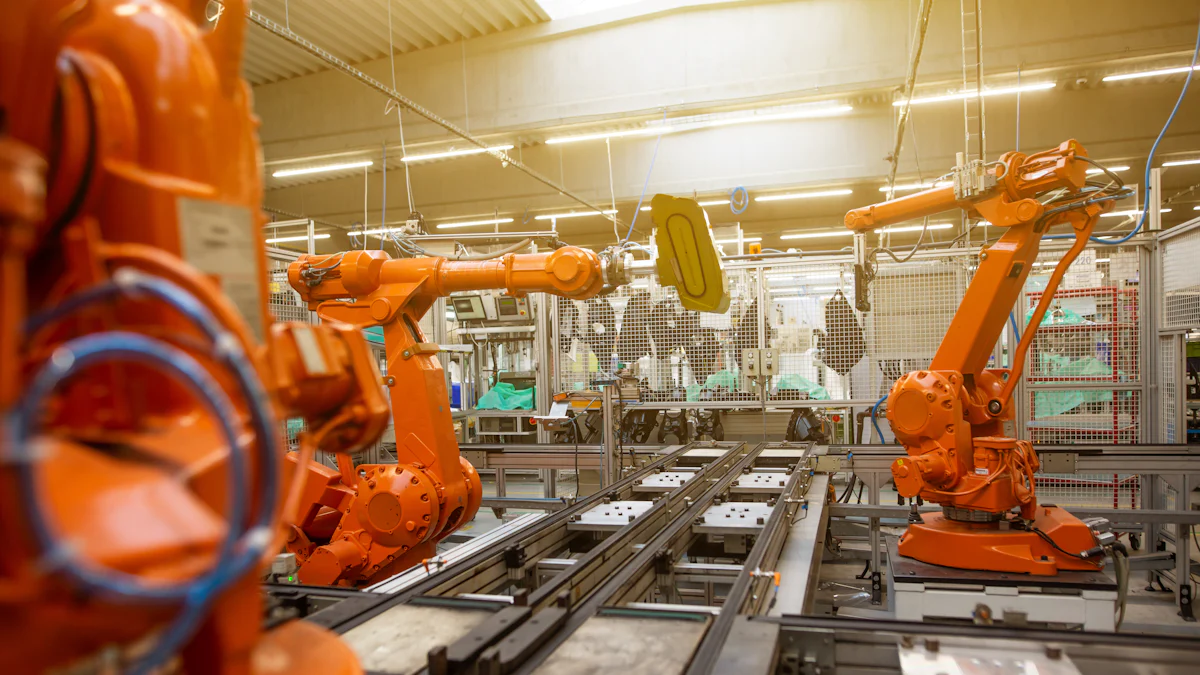Solving the Top 5 Warehouse Management Challenges of 2024

Effective warehouse management holds critical importance in 2024. Rapid technological advancements and shifting market demands present evolving challenges. Global supply chain dynamics further complicate operations. The warehouse management system market is projected to grow from USD 4.0 billion in 2024 to USD 8.6 billion by 2029, reflecting a significant increase. Addressing these challenges becomes essential for maintaining efficiency and competitiveness. This blog aims to identify the top challenges and provide actionable solutions to enhance warehouse management practices.
Challenge 1: Inventory Accuracy in Warehouse Management
Problem Identification in Warehouse Management
Issues with Manual Tracking
Manual tracking methods often lead to significant errors. Employees may misplace items or record incorrect quantities. These mistakes can disrupt the entire supply chain. Manual processes also consume a lot of time, reducing overall efficiency. TechWare, a leading electronics retailer, faced similar issues. The company struggled with extensive product ranges and fluctuating demand.
Inaccurate Data Entry
Inaccurate data entry poses another major challenge. Human error frequently results in discrepancies between recorded and actual inventory levels. This can lead to stockouts or overstock situations. Inaccurate data impacts decision-making and customer satisfaction. TechWare experienced these problems before implementing better solutions.
Solution
Implementing Automated Systems
Automated systems offer a robust solution to inventory accuracy issues. These systems reduce human error by automating data entry and tracking processes. Barcoding and RFID technologies can streamline operations. Automated systems also provide real-time updates, ensuring accurate inventory levels. TechWare adopted these technologies to enhance their inventory management.
Real-time Inventory Tracking
Real-time inventory tracking further improves accuracy. This method allows for continuous monitoring of stock levels. Real-time data helps in making informed decisions quickly. It also reduces the chances of stockouts and overstocking. TechWare saw significant improvements in efficiency and customer satisfaction after implementing real-time tracking.
Challenge 2: Space Utilization

Problem Identification
Inefficient Layouts
Many warehouses suffer from inefficient layouts. Poorly designed spaces lead to wasted time and effort. Workers spend more time locating items, which reduces productivity. A cluttered layout can also cause safety hazards. For example, narrow aisles make it difficult for forklifts to maneuver. This inefficiency impacts overall warehouse management.
Overstocking and Understocking
Overstocking and understocking present significant challenges. Overstocking leads to crowded storage areas, making it hard to find items. This situation increases the risk of damage to goods. Understocking, on the other hand, results in stockouts. Customers face delays, leading to dissatisfaction. Both scenarios disrupt the smooth flow of operations. Effective warehouse management requires balancing inventory levels.
Solution
Warehouse Layout Optimization
Optimizing the warehouse layout can solve many issues. A well-organized space improves efficiency. Workers can locate items quickly, reducing search time. Clear pathways enhance safety by allowing easy movement of equipment. Data-driven insights help in designing optimal layouts. AI optimization tools can analyze space usage patterns. These tools suggest the best arrangement for maximizing space utilization.
Using Vertical Space
Using vertical space offers another effective solution. Installing taller shelving units increases storage capacity. This approach frees up floor space for other activities. Vertical storage also makes it easier to organize items systematically. Automated retrieval systems can further enhance this method. These systems use robotics to access items stored at higher levels. Implementing vertical storage solutions improves overall warehouse management.
Challenge 3: Labor Management
Problem Identification
High Turnover Rates
High turnover rates present a significant challenge in warehouse management. Many warehouses experience frequent employee departures. This constant change disrupts operations and increases training costs. New hires need time to reach full productivity. The warehouse labor market survey revealed that 40% of operators reported improved staffing conditions, yet turnover remains an issue. High turnover impacts the consistency and efficiency of warehouse operations.
Training and Skill Gaps
Training and skill gaps also hinder effective warehouse management. Employees often lack the necessary skills for advanced technologies. Insufficient training leads to errors and inefficiencies. Workers may struggle with new systems or equipment. This gap affects overall productivity and accuracy. Addressing these gaps is crucial for maintaining a competitive edge. Increased hourly pay for warehouse shifts highlights the need for skilled labor.
Solution
Employee Training Programs
Implementing comprehensive employee training programs can address these challenges. Training programs equip workers with essential skills. These programs cover both basic and advanced warehouse operations. Hands-on training ensures employees understand new technologies. Regular training updates keep staff informed about industry changes. Effective training reduces errors and boosts productivity. Well-trained employees contribute to smoother warehouse management.
Incentive and Retention Strategies
Incentive and retention strategies play a vital role in reducing turnover. Offering competitive wages attracts skilled workers. Benefits such as health insurance and retirement plans enhance job satisfaction. Recognition programs reward employees for outstanding performance. Career development opportunities encourage long-term commitment. Implementing these strategies improves employee morale and retention. A stable workforce enhances overall warehouse management efficiency.
Challenge 4: Order Fulfillment Speed

Problem Identification
Delays in Picking and Packing
Delays in picking and packing create significant bottlenecks in warehouse operations. Workers often spend excessive time locating items due to disorganized storage. This inefficiency slows down the entire fulfillment process. The complexity of modern supply chains exacerbates these delays. Globalization and e-commerce demand faster order processing. Companies face pressure to meet customer expectations for quick deliveries.
Inefficient Order Processing
Inefficient order processing further hampers fulfillment speed. Manual processes lead to errors and slowdowns. Employees may struggle with outdated systems. These inefficiencies result in delayed shipments. Customer satisfaction suffers as a consequence. Businesses must address these issues to remain competitive. Advanced technologies offer potential solutions to streamline operations.
Solution
Streamlining Picking Processes
Streamlining picking processes can significantly enhance order fulfillment speed. Implementing automated picking systems reduces human error. Technologies like pick-to-light and voice picking guide workers efficiently. These systems improve accuracy and speed. Workers can locate and pick items faster. Optimized routes within the warehouse minimize travel time. Data-driven insights help design efficient picking paths. Companies see improved productivity and reduced delays.
Implementing Advanced Order Management Systems
Implementing advanced order management systems (OMS) addresses inefficiencies in order processing. Modern OMS integrate seamlessly with existing warehouse management systems (WMS). These systems automate order processing tasks. Real-time data provides visibility into order status. Businesses can track and manage orders more effectively. Industry experts emphasize the importance of seamless integration and real-time data. Adoption of Industry 4.0 technologies, such as IoT and automation, further enhances OMS capabilities. Companies benefit from optimized operations and faster order fulfillment.
Challenge 5: Technology Integration
Problem Identification
Legacy Systems
Legacy systems pose a significant challenge in warehouse management. Many warehouses still rely on outdated software and hardware. These old systems lack the capabilities needed for modern operations. Legacy systems often result in slow processes and inefficiencies. The inability to handle large volumes of data further complicates matters. This limitation hinders the ability to scale operations effectively.
Lack of Interoperability
Lack of interoperability between different systems creates additional problems. Warehouses use various technologies that need to work together seamlessly. Incompatible systems lead to data silos and communication breakdowns. This fragmentation disrupts workflow and reduces overall efficiency. Companies struggle to integrate new technologies with existing infrastructure. The complexity of managing multiple systems increases operational costs.
Solution
Adopting Modern WMS (Warehouse Management Systems)
Adopting modern Warehouse Management Systems (WMS) offers a robust solution. Modern WMS provide advanced features that enhance efficiency. Cloud-based WMS solutions offer quicker implementation and reduced initial costs. These systems support real-time data processing and analytics. Companies can track inventory levels and optimize storage space. The Generix Group emphasizes continuous innovation in warehouse operations. Modern WMS enable businesses to digitize key processes and improve performance.
Ensuring System Compatibility
Ensuring system compatibility is crucial for seamless operations. Businesses must select technologies that integrate well with existing systems. Compatibility reduces the risk of data silos and communication issues. Integrated systems streamline workflows and enhance productivity. Companies benefit from a unified platform that supports various functions. The GlobeNewswire highlights the advantages of cloud WMS software. Faster return on investment and reduced hardware expenses drive market growth. Ensuring compatibility allows businesses to leverage these benefits effectively.
Addressing warehouse management challenges ensures operational efficiency. Implementing the suggested solutions enhances productivity and accuracy. Automated systems and optimized layouts reduce errors and improve space utilization. Comprehensive training programs and retention strategies stabilize the workforce. Advanced order management systems and modern WMS streamline processes. Proactive and adaptable approaches prepare businesses for future changes. Efficient warehouse management maintains competitiveness in a dynamic market.
See Also
Enhancing Warehouse Efficiency with Robotics in Logistics
High-Tech Warehouse Benefits: Embracing Automation for Tomorrow
Exploring Robotic Automation for Enhanced Warehouse Efficiency
